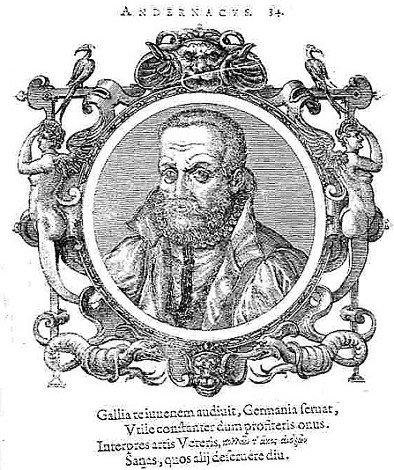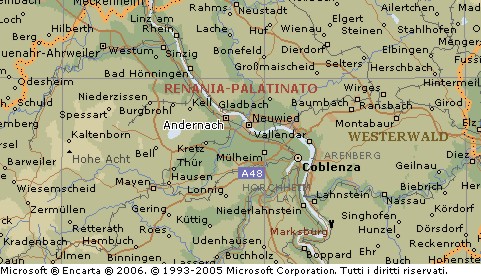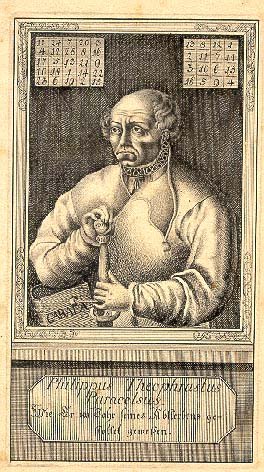Lessico
Johann Günther von Andernach

Icones veterum aliquot ac recentium Medicorum
Philosophorumque
Ioannes Sambucus / János Zsámboky![]()
Antverpiae 1574
Medico
tedesco (Andernach 1487? ca. 1505 - Strasburgo 1574). Anatomista della scuola
detta umanista perché più attenta alla rielaborazione di testi che non alla
dissezione, tradusse e studiò Galeno![]() .
Lavorò e insegnò a Parigi, dove fu anche maestro di Andrea Vesalio
.
Lavorò e insegnò a Parigi, dove fu anche maestro di Andrea Vesalio![]() .
La sua opera rappresenta un momento di passaggio tra il pensiero classico
medico greco-latino e il rinascimento scientifico.
.
La sua opera rappresenta un momento di passaggio tra il pensiero classico
medico greco-latino e il rinascimento scientifico.
Aldrovandi ne cita il De medicina veteri et nova tum cognoscenda tum faciunda commentarii duo (Basel, 1571) in cui Günther cercò di unificare la medicina di Galeno con quella di Paracelso, un lavoro dedicato all’imperatore Massimiliano II. Interessante l’ampia e documentata biografia che segue, tratta da www.whonamedit.com.

|
German
physician, born ca. 1505, Andernach; died October 4, 1574, Strassburg,
France. There is a lot of confusion both about the year of birth and
the correct name of this physician. His name is most often given as
Johann Guenther von Andernach. Other spellings being Guintherus
Andernacus, Gonthier d’Andernach, Jean Guinter d’Andernach,
Ioannes Guinterius Andernacus, and Johann Winther von Andernach. The
middle name is also frequently spelled Günther, Guinterus,
Guintherius. His year of birth is frequently erroneously given as
1487. Guinters’
native town was the ancient Roman city of Antunnacum, situated
on the west bank of the Rhine, between present cities of Bonn and
Koblenz in Rheinland-Pfalz (Rhineland-Palatinate). Nothing
is known of Guinter’s family, except that it was obscure and
impoverished, or of his earliest education. The diligent and
sharp-witted boy received his first education at the city school in
Andernach, and is said to have left his native city at the age of
twelve, in quest of learning. Guinter first studied the arts and Greek
at Utrecht, where he became befriended with the Dutch philologist
Lambert Hortensius. Then, supported by his benefactor, Duke Anton von
der Mark, went to Deventer, and Marburg, in which last place he
completed his humanistic and philosophical studies. Guinter
soon earned a reputation for learning, and thus was called to Goslar,
Saxony, as headmaster - rector - of a preparatory school. Here he
recouped his funds and was able to proceed to Louvain (Löwen) for
further study - particularly perfecting his Greek under Rutger Rescius
at the Kollegium Buslidanum (founded 1517), and also teaching of Greek,
and then to Liège (Lüttich). At some undetermined earlier time
Guinter seems to have begun the study of medicine at Leipzig, and
about 1527 he proceeded from Liège to Paris to continue that study.
This may have been due to his dire financial condition. Guinter
received the baccalaureate in medicine on April 18, 1528 after two
witnesses had sworn to the fact of his previous studies at Leipzig. On
June 4, 1530 he was promoted licentiate - Magister - and on
October 29, 1532 received the M.D. degree. The Paris Faculty of
Medicine accepted him as a regent doctor on February 6, 1533, and on
November 7, 1534 he was named one of the two professors of medicine at
a salary of twenty-five livres. As
a part of his academic duties Guinter was responsible for the annual
winter course in human anatomy, and it was inevitable during the
pre-vesalian period that his approach would be Galenic. The procedure
followed was in the medieval pattern, with Guinter lecturing to the
class while a barber or surgeon performed the actual dissection in
order merely to illustrate and confirm Galen’s anatomy. However,
Guinter himself appears occasionally to have dissected, although his
technique left much to be desired. One
of his pupils during the period 1533-1536, the later distinguished
anatomist Andreas Vesalius (1514-1564), referred to Guinter’s
anatomical instruction in strongly condemnatory terms, even declaring:
«I do not consider him an anatomist, and I should willingly suffer
him to inflict as many cuts upon me as I have seen him attempt on man
or any other animal - except at the dinner table.» Nevertheless, it
is to Guinter’s credit that he did attempt to teach his students
some comparative anatomy and was willing to allow them to gain some
experience by participating in the actual dissection. After
Vesalius had left Paris, one of Guinter’s pupils was Miguel Serveto
(1511-1553), famous for his discovery of the small circulation, and
burned on the stake in Geneva by Calvin as a heretic for his
antitrinitarian teaching. In
Paris luck smiled to Guinter, King François I appointed him one of
his physicians, he was highly esteemed by his colleagues and numerous
patients sought his help. Due to his reputation he was invited by King
Christian III of Denmark to become physician at the Danish court, but
turned the offer down. It
was in conjunction with his anatomical course that he published a
dissection manual, Institutiones anatomicae (Paris, 1536), in
four books, dealing first with the more corruptible internal organs
and then with those less susceptible to putrefaction. Thus the work
followed the form first made popular by Mondino da Luzzi (1316), that
is, the medieval method of dissection material. Guinter acknowledged
the assistance of his student Vesalius in preparation of the work,
probably the dissection and preparation of anatomical specimens.
Although Guinter’s manual, preceded only by those of Mondino and
Berengario da Carpi (1522), contained no genuine anatomical
contributions, it did advocate that anatomy, hitherto considered as
chiefly fit for study by surgeons, was fundamental to the education of
the physician. Guinter
was one of the major Greek scholars of his day, a fact first disclosed
by the publication of his Syntaxis Graeca (Paris, 1527). In
particular he devoted his scholarship to translations of the classical
writers on medicine, and in the Commentaries of the Faculty of
Medicine of Paris, he was recognized as having translated the
larger part of Galen’s writings and all those of Paul of Aegina*.
The considerable bulk of Guinter’s translations is explained by his
method, according to which, as he declared, he translated each day as
much as his secretary could write out from dictation, after which
Guinter edited the version for publication. Because
of the growing pressure of religious orthodoxy in France, Guinter, a
Lutheran, left Paris in 1538 for Metz and after about two years went
to Strassburg, where he was accepted to the Citizen’s guild under
his name of Dr. Andernach and was provided with a chair of Greek
studies at the Gymnasium, which had been established in 1538 by
Johannes Sturm. He was a friend of the Strassburg reformists,
particularly Matthias Zell (1477-1548) and his wife Katharina, and
with Martin Butzer (1491-1551). The latter obtained for him a position
as personal physician to the Pfalsgrafen Wolfgang von Zweibrücken. At
the same time he developed a medical practice. However, intrigues and
conflicts of various kinds, and criticism of his double occupation
compelled him to relinquish his academic position in 1556. During his
time in Strassburg he undertook several journeys to Germany and Italy.
Ferdinand I raised him to the nobility. Although
he continued his studies of the classical Greek physicians, producing
a translation of the writings of Alexander of Tralles in 1549, and a
revised edition in 1556, most of his later publications reflected his
interest as a practicing physician. Guinter’s
book of advice on how to avoid the plague, De victus et medicinae
ratione cum alio tum pestilentiae tempore observanda commentarius
(Strassburg, 1542), was written on the request of the city council of
Strassburg. It was translated into French by Antoine Pierre in 1544 and by Guinter in
1547 as Instruction très utile par laquelle un chacun se pourra
maintenir en santé, tant au temps de peste, comme autre temps. Further
works on this subject were Bericht, regiment, und Ordnung wie die
Pestilenz und die pestilenzialische Fieber zu erkennen und zu kurieren
(Strassburg, 1564) and De pestilentia commentarius in quatuor
dialogos distinctus (Strassburg, 1565). He
wrote a general study of medicine containing some autobiographical
material, De medicina veteri et nova tum cognoscenda tum faciunda
commentarii duo (Basel, 1571), in which he attempted to unite
Galenic medicine with that of Paracelsus. This work was devoted to
emperor Maximillian II.
Paracelso Guinter
was entombed in the church of St. Gallus in Strassburg. Guinter
was an accomplished osteologist and mycologist, although leaning too
much on Galen. Very good are also his descriptions of the female
pelvis and uterus, as well as the vagina. He was definitely one of the
foremost humanistic physicians of his time. Bibliography: Syntaxis
Graeca. Paris,
1527. De
anatomicis administrationibus.9
books of Galen, translated from Greek into Latin. Paris,
1531. Opus
de re medica. Book
of Paul of Aegina. Paris, 1532. Liber
celerum vel acutarum passionum. Book
of Caelius Aurelianus. Paris, 1533. Commentaria
in aphorismos Hippocratis. Book
of Oribasus. Paris,
1533. De
Hippocratis et Platonis placitis. Book
of Galen, translated from Greek into Latin Paris, 1534. Anatomicarum
institutionum, secundum Galeni sententiam, libri quatuor. Paris,
1536; Basel 1536; Venice, 1538; Padua, 1558. This first edition was
published as a manual for medical students, and, although the book
exerted considerable influence at the time, it was essentially Galenic
in tradition and provided little new anatomical knowledge. In the
second edition, probably published in 1540, Vesalius made a number of
changes, and it is evident that Vesalius was beginning to suspect the
errors in Galen, which he later exposed. Also included in this work is
Giorgia Valla’s (1447-1500) De humani corporis partibus.
Valla was an Italian mathematician and physician who practiced in
Milano and Venice. Later in his career he taught at Padua and occupied
a chair of rhetoric at Venice. In addition to his several medical and
mathematical works, he translated a number of Greek scientific texts
into Latin including selections from Aristotle, Hippocrates, Galen,
Rhazes, and Averroës. De
victus ed medicinae ratione cum alio tum pestilentiae tempore
observanda commentarius. Strassburg,
1542. Bericht,
regiment, und Ordnung wie die Pestilenz und die pestilenzialische
Fieber zu erkennen und zu kurieren. Strassburg,
1564. Written on the reequest of the city council of Strassburg. Avis,
Régime et ordonnance pour connaître la peste etc. Strassburg,
1564 and 1610. De
pestilentia commentarius in quatuor dialogos distinctus. Strassburg,
1565. Commentarius
de balneis, & aquis medicatis in tres dialogos distinctus. Strassburg, Excudebat Theodosius Rihelius, 1565; German translation by
Etschenreuter, 1571. In this small book on thermal springs, Guinterius
gives many interesting details on the waters of Baden near Vienna,
Baden-Baden, Ems, Karlsbad, and many other springs around Europe. De
medicina veteri et nova. Basel,
1571. An attempt at unifying Galenic medicine with that of Paracelsus.
Also containing some autobiographical material. Gynaeciorum
commentarius, de gravidarum, parturentium, puerperarum & infantium
cura . . . Accessit elenchus auctorum in re media cluentium, qui
gynaecia scriptis clararunt & illustrarunt. Opera e studio Joan.
Georgii Schenkii . . . Argentorati, Impenzis Lazari Zetzner, 1606. A
work on obstetrics published posthumously by Johann Georg Schenck of
Grafenberg (died 1620). Strassburg, 1606. Schenk wrote the first
bibliography of gynaecology, covering physicians who wrote on the
subject from the earliest times to the beginning of the 17th century.
This was appended to Guenther’s work. The title of Schenk’s
work is Pinax autorum qui gynaecia seu muliebra ex instituto
scriptis exoluerunt et illustrarunt. |
